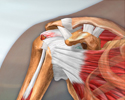Frozen shoulder - aftercare
Adhesive capsulitis - aftercare; Frozen shoulder syndrome - aftercare; Pericapsulitis - aftercare; Stiff shoulder - aftercare; Shoulder pain - frozen shoulder
A frozen shoulder causes shoulder pain that leads to stiffness of your shoulder. Often the pain and stiffness are present all the time and can worsen before they get better.
More About Your Injury
The capsule of the shoulder joint is made of strong tissue (ligaments) that hold the shoulder bones to each other. When the capsule becomes inflamed, it becomes stiff and the shoulder bones cannot move freely in the joint. This condition is called frozen shoulder.
Frozen shoulder may develop with no known cause. It can also occur in people who:
- Are 40 to 70 years old (it's more common in women, but men can still get it)
- Have thyroid disease, diabetes, or are going through menopause
- Have a shoulder injury
- Have had a stroke that makes them unable to use their arm
- Have a cast on their arm that holds their arm in one position
What to Expect
Symptoms of frozen shoulder often follow this pattern:
- At first, you have a lot of pain, which can come on abruptly even without an injury or trauma. The pain can worsen quickly even without aggravation. This is the inflammatory stage.
- Your shoulder can become very stiff and hard to move, even when the pain lessens. It becomes hard to reach over your head or behind you. This is the freezing phase.
- Finally, the pain goes away and you can use your arm again. This is the thawing phase and can take months to end.
It can take a few months to go through each stage of frozen shoulder. The shoulder can get very painful and stiff before it starts to loosen. It can take as long as 18 to 24 months for complete healing. To help speed healing, your health care provider will likely do the following:
- Teach you exercises to restore motion in your shoulder joint.
- Refer you to a physical therapist.
- Prescribe medicines for you to take by mouth. These include medicines to reduce pain and inflammation in the shoulder joint.
- You may also need a shot of anti-inflammatory medicine or steroid directly into the joint to reduce the inflammation.
Most people have a full recovery with full range of motion without surgery.
Symptom Relief
Using moist heat on your shoulder 3 to 4 times a day may help relieve some pain and stiffness.
For pain, you can use ibuprofen (Advil, Motrin), naproxen (Aleve, Naprosyn), or acetaminophen (Tylenol). You can buy these pain medicines at the store.
- Talk with your provider before using these medicines if you have heart disease, high blood pressure, kidney disease, or have had stomach ulcers or internal bleeding in the past.
- Do not take more than the amount recommended on the bottle or by your provider.
In Your Home
Get help setting up your home so that you can get to everything you need without reaching above your shoulders or behind your back.
- Keep the clothes that you wear most often in drawers and shelves that are between your waist and shoulder level.
- Store food in cupboards, drawers, and refrigerator shelves that are between your waist and shoulder level.
Get help with house cleaning, taking out the garbage, gardening, and other household tasks.
Do not lift heavy things or do activities that require a lot of shoulder and arm strength.
Shoulder Exercises
You will learn some simple exercises and stretches for your shoulder.
- At first, try to do these exercises once every hour, or at least 4 times a day.
- It is more important to do the exercises often than to do them for a long time each time you do them.
- Use moist heat before the exercises to help lessen pain and increase movement.
- The exercises should focus on stretching of the shoulder and range of motion.
- Avoid exercises to strengthen your shoulder until the range of motion has returned.
Some of the exercises are:
- Shoulder stretches
- Pendulum
- Wall crawl
- Rope and pulley stretches
- Movements to help with internal and external rotation, such as hand behind back
Your provider or physical therapist will show you how to do these exercises.
When to Call the Doctor
Contact your provider if:
- The pain in your shoulder is getting much worse even if you take pain medicine
- You re-injure your arm or shoulder
- Your frozen shoulder is making you feel sad or depressed
References
Krabak BJ, Chen ET. Adhesive capsulitis. In: Frontera WR, Silver JK, Rizzo TD Jr, eds. Essentials of Physical Medicine and Rehabilitation. 4th ed. Philadelphia, PA: Elsevier; 2019:chap 11.
Martin SD, Thornhill TS. Shoulder pain. In: Firestein GS, Budd RC, Gabriel SE, Koretzky GA, McInnes IB, O'Dell JR, eds. Firestein & Kelley's Textbook of Rheumatology. 11th ed. Philadelphia, PA: Elsevier; 2021:chap 49.
Review Date: 6/17/2024
Reviewed By: C. Benjamin Ma, MD, Professor, Chief, Sports Medicine and Shoulder Service, UCSF Department of Orthopaedic Surgery, San Francisco, CA. Also reviewed by David C. Dugdale, MD, Medical Director, Brenda Conaway, Editorial Director, and the A.D.A.M. Editorial team.


